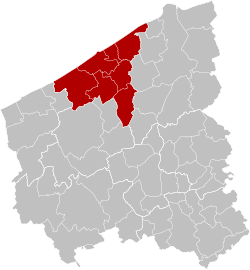Top Qs
Timeline
Chat
Perspective
Arrondissement of Ostend
Arrondissement in Flanders, Belgium From Wikipedia, the free encyclopedia
Remove ads
The Arrondissement of Ostend (Dutch: Arrondissement Oostende; French: Arrondissement d'Ostende) is one of the eight administrative arrondissements in the Province of West Flanders, Belgium. Spanning approximately 304.6 km2 (117.6 sq mi), it comprises seven municipalities. As of January 2024, it had an estimated 160,032 residents. Located in northern West Flanders, it serves as a significant economic and transport hub, with a major port, airport, and coastal tourism infrastructure centered on Ostend city.
Remove ads
History
The Arrondissement of Ostend, has a history influenced by various European powers with the city of Ostend, which is the administrative center of the arrondissement, a significant port and strategic location for centuries.[1] During the late 16th and early 17th centuries, Ostend was the site of a notable siege (1601-1604) during the Eighty Years War, highlighting its military importance.[2]
Geography
The Arrondissement of Ostend is located in the northwestern part of Belgium, within the province of West Flanders, which is part of the Flemish Region.[3] It borders the North Sea to the north, giving it a significant coastline. The topography is predominantly flat and low-lying, characteristic of the Flemish coastal plain. Much of the land along the North Sea coast is composed of sand dunes, polders (reclaimed land protected by dikes), and beaches.[1]
The Administrative Arrondissement of Ostend consists of seven municipalities: Bredene, De Haan, Gistel, Ichtegem, Middelkerke, Ostend, and Oudenburg.[4]
Remove ads
Demographics
As of January 2024, the Arrondissement of Ostend had a population of 164,159 inhabitants. This makes it one of the more populated arrondissements in West Flanders, reflecting the concentration of urban centers along the coast.[5] The economy of the arrondissement is largely driven by its coastal location and the presence of a major port. Tourism is a cornerstone of the economy, particularly in the city of Ostend and other coastal municipalities like De Haan and Middelkerke, which attract numerous visitors to their beaches and resorts.[1]
The Port of Ostend is a significant economic asset, supporting activities such as ferry services, fishing, offshore wind energy, and cargo handling.[6] Ostend-Bruges International Airport serves the region, providing both passenger and cargo flights.[7][8] A comprehensive tram line (Kusttram) runs along the entire Belgian coast, connecting all coastal towns and villages, including those within the Arrondissement of Ostend, providing convenient public transport for residents and tourists.[9]
References
Wikiwand - on
Seamless Wikipedia browsing. On steroids.
Remove ads

